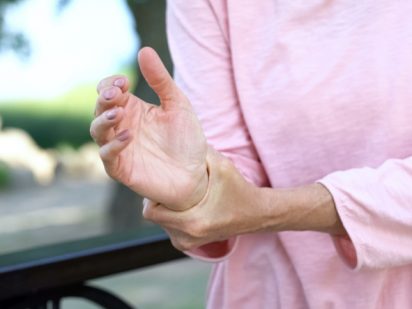Bone density scans must feel like poor cousins next to their mammography counterparts. Both screenings are important to women’s health, yet it’s mammography that gets the pink gear and all the attention.
Thankfully, this changes each May as the Bone Health & Osteoporosis Foundation (BHOF) works to generate awareness of good bone health and osteoporosis prevention during National Osteoporosis Month.
Osteoporosis is a bone disease that occurs when the body loses too much bone, makes too little, or both. As a result, bones become abnormally thin, weakened and easily broken. In severe cases, a fall or even mild stress such as coughing can cause a fracture.
“It’s often called a silent disease because people generally don’t sense that their bones are weakening,” said Renee Harju, FNP-C, a family nurse practitioner. “Breaking a bone might be the first sign of osteoporosis.”
Primary care providers like Harju are the BHOF’s most reliable allies. They perform wellness checks, order timely screenings and generally oversee prevention and management of the full range of medical conditions. “If I see that a patient has experienced a fracture that is disproportionate to the severity of the trauma, such as a fall from a standing height, I will recommend assessment for potential bone disease,” she said, adding, “I also encourage bone density screening or DEXA scan as part of a wellness evaluation.”
According to the BHOF, osteoporosis is responsible for two million broken bones annually in the U.S.
Women are at a higher risk for osteoporosis after menopause due to lower levels of estrogen. One in two women and up to one in four men will break a bone in their lifetime due to osteoporosis. For women, the incidence is greater than that of heart attack, stroke and breast cancer combined. A man is more likely to break a bone due to osteoporosis than he is to get prostate cancer, BHOF reports.
While fractures are costly in terms of direct medical costs and lost productivity, the long-term consequences are frequently life-changing. Osteoporosis-related fractures most commonly occur in the hip, wrist or spine. Of the nearly 300,000 hip fracture patients suffer annually, one-quarter require admission to long-term care and half never regain previous function. Furthermore, a quarter of hip-fracture patients age 50 and over die in the year following the fracture.
The good news is that osteoporosis is preventable and treatable. Regular exercise and good nutrition are the chief modes of defense, especially as they involve getting the recommended daily amounts of calcium and vitamin D. Both nutrients are essential to help maintain proper bone formation and density. To underscore this guidance, Harju arms her patients with information that highlights the following items:
NUTRITION – Strive for an optimal diet, including adequate protein and calories as well as plenty of calcium and vitamin D. “I recommend 1,200 mg of calcium per day with 800 international units of vitamin D,” Harju said.
ALCOHOL – Avoid drinking in excess (more than two drinks per day).
EXERCISE – Try to maintain a regular exercise schedule to improve bone mass and maintain bone density. Exercise also helps prevent falls by strengthening muscles and improving balance.
SMOKING – Quit smoking or avoid starting, as smoking is known to speed bone loss.
AVOID FALLS – Falling significantly increases the risk of osteoporotic fractures. Take measures to prevent falls, including the following:
• Remove loose rugs and electrical cords or any other loose items in the home that could lead to tripping, slipping and falling.
• Provide adequate lighting in all areas inside and around the home, including stairwells and
entrance ways.
• Avoid walking on slippery surfaces, such as ice or wet or polished floors.
• Review drug regimens to replace medications that may increase the risk of falls.
• Get regular eye exams to check vision.
Doctors measure the levels of calcium and other minerals in your bones using a DEXA scan to detect signs of osteoporosis. DEXA scans are simple and painless. Bone density tests can also determine how well osteoporosis treatment is working. Most women start screening at age 60-65, but you may need screening earlier if you’ve suffered a fracture. Like most screenings, the frequency depends on your age and risk factors. The standard recommendation is every two years.
DEXA scans can be ordered by a primary care provider and may be scheduled through Trinity Health’s Imaging and Radiology Department. For more information or to schedule an appointment in Minot, call 701-857-2640. To schedule an appointment at Trinity Health Western Dakota in Williston, call 701-774-0810.

